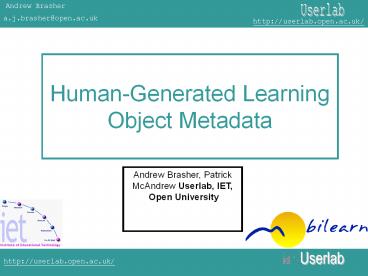Hunan-Generated Learning Object Metadata - PowerPoint PPT Presentation
1 / 29
Title:
Hunan-Generated Learning Object Metadata
Description:
Examine factors affecting quality of human generated metadata ... Currier, S., et al (2004) Chan, L.M (1989) 4. Socio-cognitive engineering. Sharples et al. (2002) ... – PowerPoint PPT presentation
Number of Views:23
Avg rating:3.0/5.0
Title: Hunan-Generated Learning Object Metadata
1
Human-Generated Learning Object Metadata
Andrew Brasher, Patrick McAndrew Userlab, IET,
Open University
2
Summary
- Examine factors affecting quality of human
generated metadata - How can ontologies and systems which exploit them
help? - Conclusions
3
Quality of human generated metadata
- Often neither complete nor consistent
- Factors which influence the quality of human
produced metadata - Motivation of the producers
- Accuracy
- Consistency
Currier, S., et al (2004)
Chan, L.M (1989)
4
Socio-cognitive engineering
Sharples et al. (2002)
5
In this talk.
- An ontology is a formal explicit specification of
a shared conceptualisation (Gruber 1993) - but.
- Issues with langauge dependence (Guarino 1998)
6
An aim of metadata
- To deliver right resources, to right people, in
the right place, at the right time to aid these
people achieve their learning goals
7
Implications
- To deliver appropriate learning objects implies
descriptions of - Temporal, spatial context
- Social context (including descriptions of people)
- Learning objects
- Devices
- Delivery infrastructure
- and processes to select and deliver the right
resources
8
For generation of LO metadata
2 sources
- Intrinsic
- Extrinsic
9
Generation of metadata
Metadata
Process
Source
10
Human intervention
In practice, there are two types of sources which
require human intervention at point of production
to create metadata descriptors
- extrinsic sources
- and
- most intrinsic sources within non-textual
resources.
11
Educational category of the IEEE Learning Object
Metadata
1) Interactivity Type 2) Learning Resource
Type 3) Interactivity Level 4) Semantic
Density 5) Intended End User Role 6) Context
7) Typical Age Range 8) Difficulty
9) Typical Learning Time 10) Description
11) Language.
1) Interactivity Type 2) Learning Resource
Type 3) Interactivity Level 4) Semantic
Density 5) Intended End User Role 6) Context
7) Typical Age Range 8) Difficulty
9) Typical Learning Time 10) Description
11) Language.
Extrinsic sources e.g. expected use
Most intrinsic sources within non-textual
resources
2 sources requiring human generation of metadata
12
Example
very easy easy medium difficult very difficult
- Difficulty
How hard it is to work with or through this
learning object for the typical intended target
audience. NOTEThe typical target audience
can be characterized by data elements 5.6Educatio
nal.Context and 5.7Educational.TypicalAgeRange.
IEEE, (2002).
13
Example Learning in the connected economy
14
Example Learning in the connected economy
15
How to create difficulty meatadata?
- By authors using structured vocabularies
- Task analysis
16
Metadata creation
Kabel et al., 2003
VDEX, 2004
17
Example LO
18
Example
19
Categorisation
Typical learning time / hours Difficulty
lt 1 Very easy
1 lt Typical learning time lt 3 Easy
3 lt Typical learning time lt 4 Medium
Typical learning time gt 4 Difficult
20
Multiple Contexts
- Previous idea works for a single context
- What about multiple contexts?
- Who?
- How could it be exploited?
21
Goal
- To enable a system to compare the difficulty of
LOs on the same topic - designed for different target audiences
- Looking for a general solution
22
easy
easy
Target audience
Target audience
context1 (Art History degree)
context2 (museum)
23
Metadata Creation
- Art history degree course team create difficulty
metadata - Museum guide team create difficulty metadata
- Relationship metadata created by managers
24
ContextRelationship class The ContextRelationship
class describes relationships between assignments
of difficulty in different contexts. An example
of how data contained within an instance should
be interpreted is "For students in the Museum
context, the assignments of difficulty made for
students in the Art History degree context are
more difficult."
easy
easy
Target audience
Target audience
context1 (Art History degree)
context2 (museum)
25
Ontology
- Assignments of difficulty made in this context
context1 are perceived as more difficult than
assignments of difficulty made in this context
context2 - Assignments of difficulty made in this context
context1 are perceived as less difficult than
assignments of difficulty made in this context
context2 - Assignments of difficulty made in this context
context1 are perceived as as difficult as
assignments of difficulty made in this context
context2
26
Multiple contexts
More difficult than
Possibility of disagreements?
Possibility of refinements?
context1 (Art History degree)
context2 (museum)
27
Conclusions
- Consider and exploit endemic motivation in the
system design - Single context LOM schema sufficient(?)
- Multiple contexts more complex
28
Future plans
- More complex representation needed
- Ontology / OWL
- Other domains
- User Profiles
- Task model
Metadata creation task model - Ontologies are one
of the many tools that can be used
- Forget this its never going to work!
29
(No Transcript)































